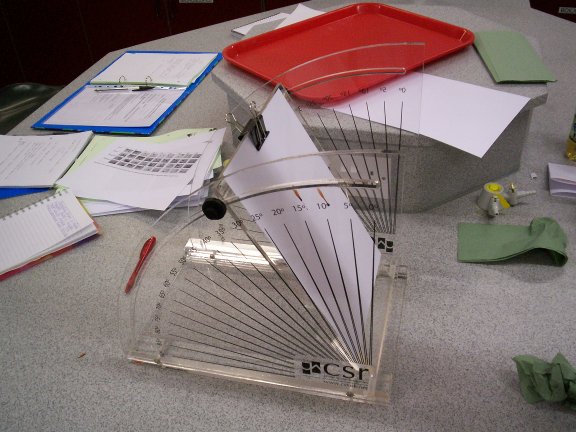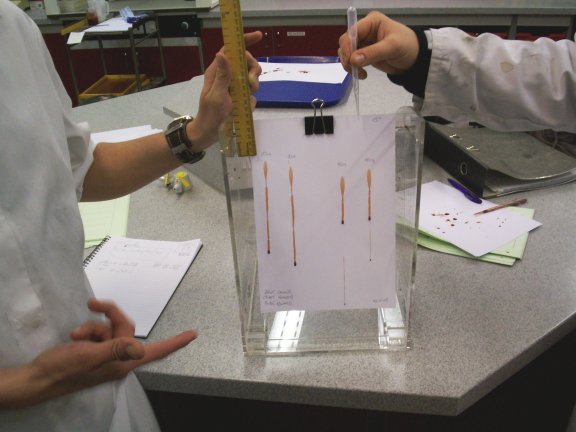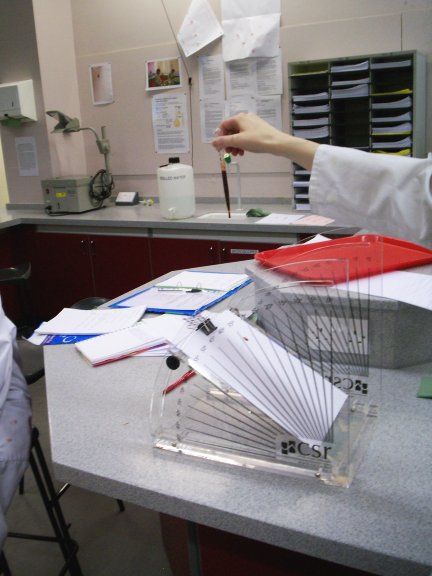One use of the inclined plane

Summary :: Pupose made inclined plane makes practical work less confusing for students, and looks the part. Students studying a Maths unit as part of the BTEC National Certificate and Award in Forensic Scence find the practical work and relatively ‘real’ context motivates the Maths. As we all know, if students can be cajoled to do Maths, it sticks and then generates intrinsic motivation.
There is a simple formula (A = arcsin(w/l)) used to calculate the angle of impact of a liquid drop on a surface. The assumption is that the drop is spherical and that the stain will be elliptical – just like projecting a parallel beam of light of circular cross-section onto the surface. You just can’t beat the conic sections!
This formula is found in forensic science textbooks (White, Jackson & Jackson) as a way of working out the angle at which a blood stain hits a wall. I base part of a forensic maths assignment on an experimental test of this formula. Students have to
- work in pairs or threes to devise an experiment to test the formula
- discuss how to allow comparison of results between the groups
- carry out the experiment and note any changes to the plan that become necessary
- process and present the results including a quantitative estimate of the error bound for each angle they test
- discuss the results and come to a conclusion about how far they trust the formula

Forensic experts will tell you that the main point of blood stain pattern analysis is to determine the position of impact within a few metres (ie was the victim lying down or standing up when hit with the blunt instrument) so 5 degrees either way will decide the case. I encourage students to follow through a simple error analysis. Errors of two or three degrees are typical within the range 20 to 80 degrees. Errors can become larger outside that range.
The independent variable is the true angle of impact of the liquid drop, the dependent variable is the angle of impact estimated from the ellipse. Factors involve the nature of the paper surface and the viscosity and ‘thickening’ of the liquid. Central to the experiment is some kind of inclined plane.
Until recently, I have been using a dissection board propped against the wall and held with a 5Kg weight as the inclined plane. Students measured the length of the dissection board and then measured the height of the upper end of the board against the wall, and then used trigonometry to work out the angle between the board and the bench, the complimentary angle being the true angle of impact. This is a fairly long chain of arithmetic, and the calculations are dangerously similar to the calculation of impact angle from the ellipse. Some students get confused with the error calculation with the measurements of the dissection board and others find the geometry difficult to untangle. The independent and dependent variables become muddied in a sea of calculations.
I’ve checked the education supply companies, but there was nothing that seemed suitable. A small forensic science company called Crime Scene Resources is making ‘angle boards’ designed specifically for this kind of measurement, and we bought two on sight. The first experiment with a small group of evening class students has gone well. This simple (but nicely engineered) device has clarified the practical and made it possible for me to give evening class students a useful educational experience.
I usually wait for the simulated blood (a mixture of treacle and milk, recipe from Paul Smithard) to dry, then put the paper samples into plastic A4 pockets, and then I scan them. We load the results into PhotoShop and measure the width and length of the stain. An alternative is to import the scan into Word and use the drawing tools to match an ellipse to the stain, then right click and read off the size. A small US company supplies the HemoSpat bloodstain pattern analysis software. Perhaps someone should suggest that the UK spelling of haemo should appear in the site text somewhere! The company supplies a demo version for Mac OS X and Windows 2000/XP.
Related posts
- Simulated blood stains
- Measuring bloodstains with Photoshop
- Simulated blood recipe
- Blood spatter pattern analysis
Links
- Crime Scene Resources
- Flash animation of the angle board in use
- HemoSpat bloodstain pattern analysis software
- Wikipedia article [check against textbooks]
